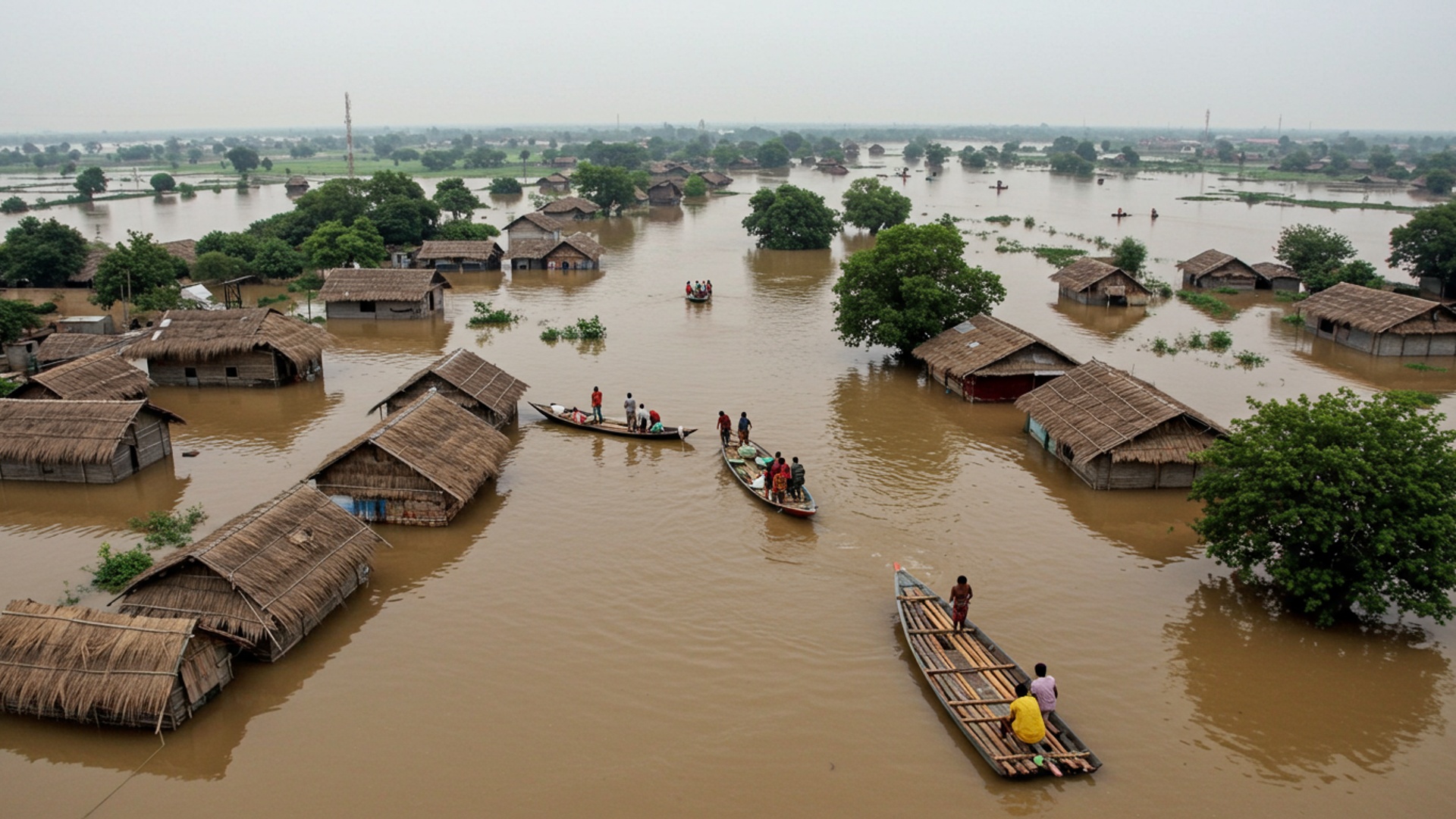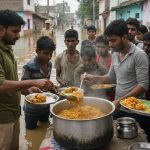Devastating floods now cover ten districts across Bihar, leaving millions of people in a desperate situation. Swollen rivers burst their banks, submerging villages, homes. farmlands as heavy rains continue to fall. Roads are impassable and communication lines are down, cutting off countless families who desperately need rescue and aid. This massive natural disaster forces people to flee with what little they can carry, as the waters rise higher each hour, threatening lives and livelihoods across the region.
Heavy Rains Cause Widespread Flooding
Bihar is currently facing a severe flood situation as continuous heavy rainfall has led to major rivers overflowing their banks. This has resulted in widespread waterlogging and has deeply impacted many lives. The rising water levels in rivers like the Ganga, Gandak, Sone, Kosi, Mahananda. Bagmati have caused them to flow above danger marks in various places.
The intense downpour, both within Bihar and in the upstream areas of Nepal, has significantly increased the volume of water in these rivers. Reports from local officials indicate that it is one of the highest water levels seen in recent history, with the Kosi River’s water level rising above the Birpur barrage for the first time.
Areas Deeply Affected
At least ten districts across Bihar have been hit hard by the floods, submerging large areas and impacting a significant number of people. Over 1. 9 million to 2. 5 million people have been directly affected by the ongoing flood crisis. The worst-affected districts include Bhagalpur, Munger, Begusarai, Vaishali, Bhojpur, Khagaria, Patna, Lakhisarai, Supaul. Buxar. In Bhagalpur alone, more than 450,000 to 650,000 people have been affected, with floodwaters entering residential and commercial areas, including university campuses. Begusarai district has seen over 350,000 people impacted, while around 150,000 people in Patna district are affected by the rising Ganga and its smaller rivers.
In addition to these, districts such as West and East Champaran, Araria, Kishanganj, Gopalganj, Sitamarhi, Sheohar, Muzaffarpur, Siwan, Madhepura, Purnea, Madhubani, Saran. Saharsa have also experienced severe flooding in recent months due to similar river overflow and embankment breaches. More than 500 villages in various districts remain under water, forcing residents to move to higher grounds like national highways and embankments.
Impact on Daily Lives and Property
The floods have brought daily life to a standstill for millions. Homes, schools. major roads are submerged, making travel very difficult. Many families have been forced to leave their homes and seek safety. They are now taking shelter in temporary tents, on elevated platforms, or along highways. This mass movement of people has led to thousands being displaced, with many still waiting for rescue teams in remote, submerged villages.
The damage to property is extensive. Agricultural fields, which are the main source of income for most rural families in Bihar, are completely submerged. Standing crops like paddy, maize. various vegetables have been destroyed, threatening food supply and the livelihoods of farmers. The floods have also caused significant losses of livestock, with many animals perishing and a shortage of fodder available for those that remain.
Infrastructure, including essential roads and a large number of government-run schools, has been damaged or closed. Some universities have had to postpone exams due to the deep floodwaters. The disaster has also damaged over 2,000 toilets in affected villages, with many being fully destroyed, leading to challenges with open defecation, especially for women.
Government Response and Relief Efforts
The government of Bihar has quickly responded to the crisis, putting in place various measures to help affected people. Chief Minister Nitish Kumar has held meetings with officials to check on relief efforts and has given direct orders for help to reach those in need. Rescue operations are being carried out by teams from the National Disaster Response Force (NDRF) and the State Disaster Response Force (SDRF). A total of 32 teams from these forces are working to rescue people and move them to safer places.
To provide immediate shelter and food, relief camps have been set up in various districts, housing thousands of displaced individuals. More than 588 community kitchens are operating, providing cooked meals to hundreds of thousands of people daily.
“All required steps to provide relief to the flood-affected people are being taken… Food is being provided to the flood-affected people, medicines are being provided by the health department,” stated Agriculture Minister Mangal Pandey.
In addition to cooked meals, dry ration packets and polythene sheets have been distributed to families. To help with movement and medical needs, over 1,200 boats have been deployed, including 13 boat ambulances equipped with mobile medical teams. Air force helicopters have also been used to drop dry food items to people stuck in hard-to-reach villages.
Special attention is being given to children and pregnant women, with health camps providing medical care. Officials have also made arrangements for animal fodder and veterinary care for livestock. School damage assessments are being conducted. funds have been given for repairs and cleaning of schools, with some starting to reopen as water recedes. Child-friendly spaces have also been set up to support children.
Challenges in Providing Aid
Despite the ongoing efforts, aid distribution faces several challenges. The sheer scale of the disaster, with millions affected across many districts, makes it difficult to reach everyone quickly. Access to some flood-hit areas remains difficult due to strong water currents and damaged roads and other structures. People displaced to higher grounds like embankments often face severe shortages of relief materials.
One major concern for affected communities is access to clean drinking water, food. medical supplies. The risk of waterborne diseases is high due to stagnant water and poor sanitation, especially with damaged toilets forcing people to use open spaces.
Mahendar Yadav, an activist working in the flood-prone Kosi region, highlighted the particular difficulties faced by women, stating, “We are forced to defecate in the open and we have to set aside our shame to do so.” He emphasized the need for temporary toilets in these situations.
Community Efforts and Support
Local communities and non-government organizations are playing a vital role in supporting the relief efforts. Active youth groups at the local level are helping to move people from flooded areas to safer places and transport them to government-run community kitchens. Organizations like SEEDS are working on the ground in districts such as Darbhanga and Saharsa, providing hygiene kits and dry food items. coordinating with district officials to confirm damage reports.
These groups are focusing on immediate relief and recovery, aiming to ensure the safety and well-being of flood-affected families. Their efforts are crucial in reaching vulnerable populations and addressing immediate needs, working alongside government agencies to provide comprehensive support during this challenging time.
![]()








